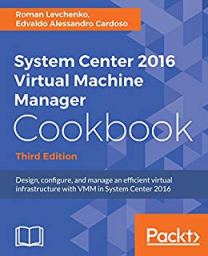Archive
High Availabilty. Why Hyper-V delivers better
That’s kind of interesting subject to talk about
Taking as a sample 3 cluster node, where every node has 1(one) connection to a shared storage.
By using VmWare, if one of the VmWare hosts ever lose the IP storage connectivity ( an fault on the ISCSI nic for example ), your Virtual Machines are on the dark, you will probably receive an Blue Screen. The VmWare monitoring will try to start (vmotion) the Virtual machine on the same host or on any other host that has storage connectivity.
Now, the clever solution from the Hyper-V
if the one of the Hyper-V hosts lose IP storage connectivity ( an fault on the ISCSI nic for example ), the Hyper-V will redirect the Storage traffic to the CSV and the VM still working : no blue screen, no restart.
In a Hyper-V Failover Cluster with CSV, all storage I/O is Direct I/O meaning each node hosting a virtual machine(s) is writing directly (via Fibre Channel, iSCSI, or SAS connectivity) to the CSV volume. But in case of lost of Storage connectivity in one of the hosts the traffic will be redirected over the CSV network to another node Host in the cluster which still has direct access to the storage supporting the CSV volume. This functionality prevents the loss of all connectivity to storage. Instead, all storage related I/O is redirected over the CSV network. This is very powerful technology as it prevents a total loss of connectivity thereby allowing virtual machine workloads to continue functioning.
Of course there are other fault scenarios to consider and yes, I know that the recommedation is to have redundant storage connection, but that’s kind of expensive solution and does not take the fact that the Hyper-V solution is more clever.
If you ever experienced this situation I would like to hear your input.
Determine Windows Server 2012 readiness : MAP Toolkit v7.0 Beta now available. Find out about more new features
Key Features for a detailed insight to address an upgrade, migration, virtualization :
- Understand your readiness to deploy Windows in your environment with Windows readiness assessments
- Determine Windows Server 2012 Beta readiness
- Investigate how Windows Server and System Center can manage your heterogeneous environment through VMware migration and Linux server virtualization assessments
- Size your desktop virtualization needs for both Virtual Desktop Infrastructure (VDI) and session-based virtualization using Remote Desktop Services
- Ready your information platform for the cloud with the SQL Server 2012 discovery and migration assessment
- Evaluate your licensing needs with usage tracking for Lync 2010, active users and devices, SQL Server 2012 and Windows Server 2012 Beta
You can use the MAP Toolkit to accomplish the following tasks:
- Desktop and server migration to a Windows Operating System such as Windows 8, Microsoft Office 2010, Microsoft Office 365, and Windows Server 2012, Windows 7 and Windows Thin PC.
- Assess and identify computers running Windows Server operating systems in your environment.
- Assess and identify computers running virtual technologies in your environment.
- Discover and report on computers running Microsoft, VMware, HP-UX and Linux platforms, including the Linux, Apache, MySQL, and PHP (LAMP) application stacks in your environment.
- Assess and identify computers that have outdated or no security-based software (antispyware, antivirus, and firewall products) in your environment.
- Discover and report on computers that are virtual machine candidates.
- Assess and inventory Microsoft SQL Server® instances, databases, and components in your environment.
- Discover MySQL, Oracle, and Sybase databases in your environment and assess the ability to migrate to Microsoft SQL Server.
- Dual-core 1.5GHz processor, 2 GB RAM (Itanium processors are not supported)
Operating system. Any of the following:
- Windows Server 2012, W2008R2 SP2, W2008 SP2 (x86 or x64 versions)
- Windows 7 SP1 (x86 or x64 versions)
- Windows Vista SP2 (x86 or x64 versions)
Software pre-req
- Windows Installer 4.5 (download from http://go.microsoft.com/fwlink/?LinkId=129687)
- .NET Framework 3.5SP1 (3.5.30729.01) (download from http://go.microsoft.com/fwlink/?LinkId=129686)
- .NET Framework 4.0 (Full) (download from http://go.microsoft.com/fwlink/?LinkId=186913)
- Update 2 for Microsoft.NET Framework 4.0 (download from http://support.microsoft.com/kb/2544514). Full download http://go.microsoft.com/fwlink/?LinkId=207290
- By default, the MAP Toolkit will install SQL Server 2012 Express LocalDB during setup.
Note: if you create an instance named “MAPS” before running the MAP Toolkit installer, you may also use an existing installation of SQL Server 2008, SQL Server 2008 R2, or SQL Server 2012 . The MAP Toolkit requires the collation order of the database engine to be set to “SQL_Latin1_General_CP1_CI_AS”.
Recommendations
- Do no install on a domain controller.
- Close all open applications before running the setup wizard.
- If your firewall doesn’t accept listing a service like WMI or Remote Administration, you will also need to open ports 135 and 1024-65535. The reason for this has to do with the way RPC works. WMI uses DCOM to communicate with remote machines, and DCOM uses RPC extensively
- If the computer is in a workgroup, you must manually change the “Network access: Sharing and security model for local accounts” policy setting from Guest only to Classic on the local computer
- To connect remotely and perform the WMI inventory, you will need to provide accounts that are members of the local Administrators group on the computer being inventoried
Collectors by Inventory Scenario:
- Windows computers – WMI
- Linux/UNIX computers – SSH
- VMware computers – VMware
- Active Devices and Users – Active Directory, WMI
- Exchange Server – Active Directory, WMI
- Forefront Endpoint Protection Server – PowerShell, WMI
- Lync Server – PowerShell, SQL Native, SQL Windows, WMI
- SQL Server Inventory – WMI
- SQL Server with Database Details – SQL Native, SQL Windows, WMI
- Windows Azure Platform Migration – Oracle, SQL Native, SQL Windows, SSH, WMI
- MySQL, Oracle and Sybase – Oracle, SSH, WMI
download from http://go.microsoft.com/fwlink/?LinkId=219165




